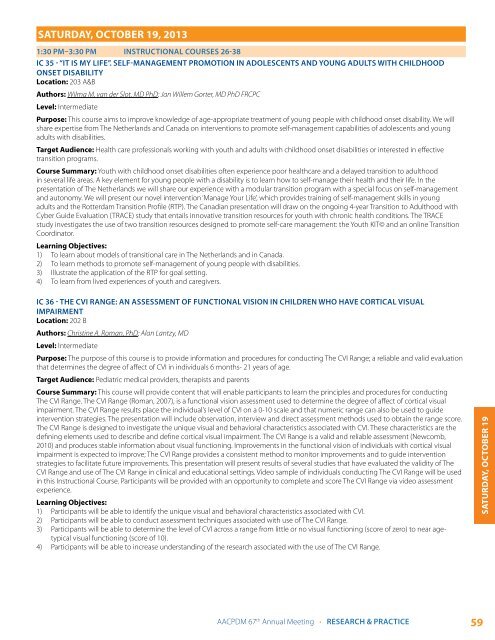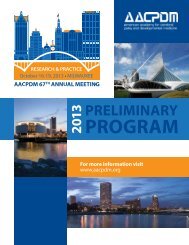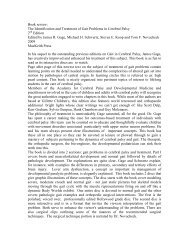Saturday, October 19, 20131:30 pm–3:30 pm Instructional Courses 26-38IC 33 - TOE WALKING: HOW DO YOU KNOW WHO TO WORRY ABOUT?Location: 202 D&EAuthors: Kristan A. Pierz, MD; Sylvia Ounpuu, MScLevel: BasicPurpose: The purpose of this course is to describe the many variations of toe walking to help clinicians underst<strong>and</strong> the diversity ofpresentation, underlying diagnoses, <strong>and</strong> treatment options.Target Audience: Physicians, mid-level practitioners, physical therapists, orthotists, kinesiologists, <strong>and</strong> others who are interested in a moredetailed underst<strong>and</strong>ing of toe walking <strong>and</strong> how to assess <strong>for</strong> underlying diagnoses.Course Summary: Toe walking is frequently seen in childhood. Although the idiopathic version is common, caregivers need to be aware ofunderlying, often subtle, etiologies that warrant evaluation <strong>and</strong> timely treatment. This course will begin with a selection of videos of patientswho toe walk followed by a brief review of disorders that may result in toe walking (e.g. spasticity/cerebral palsy, weakness/hereditarysensory motor neuropathies, limb asymmetry/leg length difference/hip dysplasia/joint contractures/tumors, sensory integration disorders,<strong>and</strong> idiopathic/habitual patterning). The course will provide an overview of the comprehensive assessment of toe walking including thefollowing: visual/video analysis, physical exam, kinematics, <strong>and</strong> electromyography (EMG) <strong>and</strong> how each of these components can support orrefute differential diagnoses. The initial cases will then be examined in more detail, focusing on the gait parameter differences. Clinical examfindings, sagittal plane ankle/knee/hip/pelvis kinematic profiles, <strong>and</strong> EMG data will be used to support or refute different diagnoses <strong>and</strong>treatment options.Learning Objectives:1) Be familiar with the limitations of assessing toe walking by observation alone.2) Be familiar with many of the underlying diagnoses associated with the clinical presentation of toe walking.3) Be familiar with the components of computerized gait analysis relevant to toe walking.4) Be aware of “red flags” or gait features of toe walkers that warrant additional evaluation or treatment.Saturday, October 19IC 34 - REVIEW OF NEUROPHARMACOLOGY IN PEDIATRIC BRAIN INJURYLocation: 101 AAuthors: John Pelegano, MD; Jilda N. Vargus-Adams, MD MSc; Micah W. Baird, MDLevel: IntermediatePurpose: This course will present a review of the literature <strong>and</strong> current practices regarding the use of neuropharmacologic agents in thetreatment of children with moderate to severe acquired brain injuries (ABI).Target Audience: Physicians, physician assistants, advanced practice nurses, occupational <strong>and</strong> physiotherapists, speech <strong>and</strong> languagepathologists, nursesCourse Summary: A 2010 study estimated that the number of hospitalizations <strong>for</strong> Traumatic Brain Injury in children ages 0 -14 years wasjust over 35,000 annually. Over the past several years there has been increasing use of pharmacologic agents as adjuncts to the rehabilitationof these individuals. Though most of the limited number of clinical studies that have been per<strong>for</strong>med to date have been per<strong>for</strong>med in theadult population these medications are increasingly finding their way into pediatric usage. This course will provide a review of existingliterature on this topic <strong>and</strong> provide a framework <strong>for</strong> the judicious use of these agents in clinical settings.Learning Objectives:1) To become aware of the array of neuropharmacologic agents which have been utilized to augment the rehabilitation of children withABI’s.2) To review the available literature on neuropharmacology in ABI including ratings of Level of Evidence.3) Become familiar with a clinical framework <strong>for</strong> the judicious use of these medications in children with ABI.4) Become familiar with those areas of neuropharmacology in ABI requiring further study.58<strong>American</strong> <strong>Academy</strong> <strong>for</strong> <strong>Cerebral</strong> <strong>Palsy</strong> <strong>and</strong> Developmental Medicine • FINAL PROGRAM
Saturday, October 19, 20131:30 pm–3:30 pm Instructional Courses 26-38IC 35 - “IT IS MY LIFE”. SELF-MANAGEMENT PROMOTION IN ADOLESCENTS AND YOUNG ADULTS WITH CHILDHOODONSET DISABILITYLocation: 203 A&BAuthors: Wilma M. van der Slot, MD PhD; Jan Willem Gorter, MD PhD FRCPCLevel: IntermediatePurpose: This course aims to improve knowledge of age-appropriate treatment of young people with childhood onset disability. We willshare expertise from The Netherl<strong>and</strong>s <strong>and</strong> Canada on interventions to promote self-management capabilities of adolescents <strong>and</strong> youngadults with disabilities.Target Audience: Health care professionals working with youth <strong>and</strong> adults with childhood onset disabilities or interested in effectivetransition programs.Course Summary: Youth with childhood onset disabilities often experience poor healthcare <strong>and</strong> a delayed transition to adulthoodin several life areas. A key element <strong>for</strong> young people with a disability is to learn how to self-manage their health <strong>and</strong> their life. In thepresentation of The Netherl<strong>and</strong>s we will share our experience with a modular transition program with a special focus on self-management<strong>and</strong> autonomy. We will present our novel intervention ‘Manage Your Life’, which provides training of self-management skills in youngadults <strong>and</strong> the Rotterdam Transition Profile (RTP). The Canadian presentation will draw on the ongoing 4-year Transition to Adulthood withCyber Guide Evaluation (TRACE) study that entails innovative transition resources <strong>for</strong> youth with chronic health conditions. The TRACEstudy investigates the use of two transition resources designed to promote self-care management: the Youth KIT© <strong>and</strong> an online TransitionCoordinator.Learning Objectives:1) To learn about models of transitional care in The Netherl<strong>and</strong>s <strong>and</strong> in Canada.2) To learn methods to promote self-management of young people with disabilities.3) Illustrate the application of the RTP <strong>for</strong> goal setting.4) To learn from lived experiences of youth <strong>and</strong> caregivers.IC 36 - THE CVI RANGE: AN ASSESSMENT OF FUNCTIONAL VISION IN CHILDREN WHO HAVE CORTICAL VISUALIMPAIRMENTLocation: 202 BAuthors: Christine A. Roman, PhD; Alan Lantzy, MDLevel: IntermediatePurpose: The purpose of this course is to provide in<strong>for</strong>mation <strong>and</strong> procedures <strong>for</strong> conducting The CVI Range; a reliable <strong>and</strong> valid evaluationthat determines the degree of affect of CVI in individuals 6 months- 21 years of age.Target Audience: Pediatric medical providers, therapists <strong>and</strong> parentsCourse Summary: This course will provide content that will enable participants to learn the principles <strong>and</strong> procedures <strong>for</strong> conductingThe CVI Range. The CVI Range (Roman, 2007), is a functional vision assessment used to determine the degree of affect of cortical visualimpairment. The CVI Range results place the individual’s level of CVI on a 0-10 scale <strong>and</strong> that numeric range can also be used to guideintervention strategies. The presentation will include observation, interview <strong>and</strong> direct assessment methods used to obtain the range score.The CVI Range is designed to investigate the unique visual <strong>and</strong> behavioral characteristics associated with CVI. These characteristics are thedefining elements used to describe <strong>and</strong> define cortical visual impairment. The CVI Range is a valid <strong>and</strong> reliable assessment (Newcomb,2010) <strong>and</strong> produces stable in<strong>for</strong>mation about visual functioning. Improvements in the functional vision of individuals with cortical visualimpairment is expected to improve; The CVI Range provides a consistent method to monitor improvements <strong>and</strong> to guide interventionstrategies to facilitate future improvements. This presentation will present results of several studies that have evaluated the validity of TheCVI Range <strong>and</strong> use of The CVI Range in clinical <strong>and</strong> educational settings. Video sample of individuals conducting The CVI Range will be usedin this Instructional Course. Participants will be provided with an opportunity to complete <strong>and</strong> score The CVI Range via video assessmentexperience.Learning Objectives:1) Participants will be able to identify the unique visual <strong>and</strong> behavioral characteristics associated with CVI.2) Participants will be able to conduct assessment techniques associated with use of The CVI Range.3) Participants will be able to determine the level of CVI across a range from little or no visual functioning (score of zero) to near agetypicalvisual functioning (score of 10).4) Participants will be able to increase underst<strong>and</strong>ing of the research associated with the use of The CVI Range.Saturday, October 19AACPDM 67 th Annual Meeting • Research & Practice 59
- Page 1 and 2:
2013 FINALProgramFor more informati
- Page 3 and 4:
2012-2013 BOARD OF DIRECTORSPreside
- Page 5 and 6:
Meeting at a GlanceFRIDAY, OCTOBER
- Page 7 and 8: 67th Annual MeetingOctober 16-19, 2
- Page 9 and 10: AACPDM 67 th Annual Meeting2013 Mob
- Page 11 and 12: General Meeting InformationTicketed
- Page 13 and 14: Membership BenefitsHow can you bene
- Page 15 and 16: Invited LecturersStrategic Research
- Page 17 and 18: Grants and ScholarshipsAACPDM Resea
- Page 19 and 20: Wednesday, October 16: Pre-Conferen
- Page 21 and 22: Wednesday, October 16: Pre-Conferen
- Page 23 and 24: Thursday, October 17, 20137:00 am-7
- Page 25 and 26: Thursday, October 17, 20138:00 am-1
- Page 27 and 28: Thursday, October 17, 201310:45am -
- Page 29: Thursday, October 17, 20132:00 pm -
- Page 32 and 33: Thursday, October 17, 2013THURsday,
- Page 34 and 35: Thursday, October 17, 2013THURsday,
- Page 36 and 37: Friday, October 18, 20136:00 am-6:4
- Page 38 and 39: Friday, October 18, 20137:00 am-7:5
- Page 40 and 41: Friday, October 18, 201310:30 am-12
- Page 42 and 43: Friday, October 18, 201312:30 pm -
- Page 44 and 45: Friday, October 18, 20134:00 pm - 6
- Page 46 and 47: Friday, October 18, 20134:00 pm - 6
- Page 48 and 49: Friday, October 18, 20134:00 pm - 6
- Page 50 and 51: Saturday, October 19, 20137:00 am-7
- Page 52 and 53: Saturday, October 19, 20138:00 am-1
- Page 54 and 55: Saturday, October 19, 201310:15 am-
- Page 56 and 57: Saturday, October 19, 20131:30 pm-3
- Page 60: Saturday, October 19, 20131:30 pm-3
- Page 63 and 64: Scientific PostersSP1 - REDUCTION I
- Page 65 and 66: Scientific PostersSP38 - IMPACT OF
- Page 67 and 68: Demonstration PostersDP1 - TRACKING
- Page 69 and 70: AACPDM Past and Future Presidents19
- Page 71 and 72: Exhibiting and Sponsoring Organizia
- Page 73 and 74: Exhibiting and Sponsoring Organizia
- Page 75 and 76: Disclosure IndexA=Research and inst
- Page 77 and 78: Disclosure IndexG9 Park, M (F) Chun
- Page 79 and 80: Disclosure IndexInvited SpeakersBac
- Page 81 and 82: Author IndexChan, Jeremy ..........
- Page 83 and 84: Author IndexGutman, Karli .........
- Page 85 and 86: Author IndexMatsumoto, Hiroko. ....
- Page 87 and 88: Author IndexSSaavedra, Sandra .....
- Page 89: Author IndexWingate, Martha .......







